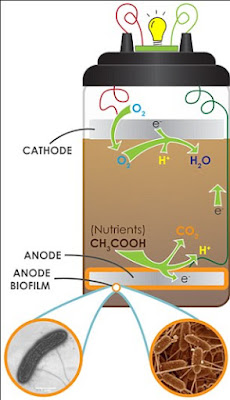Space bacteria found in British river could be new power source for the world | Mail Online
Bacteria usually found orbiting high above the Earth have been found in a British river - and could be a new power source for the world.
The mysterious organisms, found in the the mouth of the River Wear, in Sunderland, can generate electricity using a special battery called a microbial fuel cell.
The Bacillus stratosphericus - usually found 20 miles above the Earth - is believed to have been brought to the surface by atmospheric cycling, which causes evaporated water rise into the stratosphere and then fall again.
Microbial fuel cell: How bacteria can generate electricity
Inside an MFC, the organisms produce carbon dioxide, protons and electrons when kept in a solution without oxygen.
Liberated electrons form a negatively charged anode while the protons create a positively charged cathode.This produces both charges necessary to produce an electric current.
Bugs from space offer new source of power - Press Office - Newcastle University
Publishing their findings today in the American Chemical Society’s Journal of Environmental Science and Technology, Grant Burgess, Professor of Marine Biotechnology at Newcastle University, said the research demonstrated the “potential power of the technique.”
“What we have done is deliberately manipulate the microbial mix to engineer a biofilm that is more efficient at generating electricity,” he explains.
“This is the first time individual microbes have been studied and selected in this way. Finding B.Stratosphericus was quite a surprise but what it demonstrates is the potential of this technique for the future – there are billions of microbes out there with the potential to generate power.”
The use of microbes to generate electricity is not a new concept and has been used in the treatment of waste water and sewage plants.
Microbial Fuel Cells, which work in a similar way to a battery, use bacteria to convert organic compounds directly into electricity by a process known as bio-catalytic oxidation.
A biofilm – or ‘slime’ – coats the carbon electrodes of the MFC and as the bacteria feed, they produce electrons which pass into the electrodes and generate electricity.
Until now, the biofilm has been allowed to grow un-checked but this new study shows for the first time that by manipulating the biofilm you can significantly increase the electrical output of the fuel cell.
Related
- Stratospheric superbugs offer new source of power
- 'Space Superbugs,' Slimy Bacteria From Stratosphere, Eyed As New Fuel Cell Power Source
- Space Bacteria Boost Fuel Cell Power : Discovery News
- 'Bacteria battery' boosted by space microbes found in river Wear | Environment | guardian.co.uk
- Enhanced Electricity Production by Use of Reconstituted Artificial Consortia of Estuarine Bacteria Grown as Biofilms - Environmental Science & Technology (ACS Publications)
- Superbugs from space offer new source of power
- Science Friday Archives: Powering Up...With A Microbial Fuel Cell

